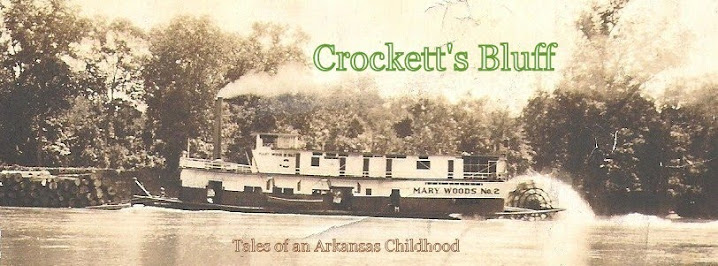My recent visit to Arkansas County was more hurried than I had hoped but it did include stops at DeWitt for a book signing event, at St. Charles for a stop at the cemetery and several old and abandoned structures that were alive and significant in the 1950s, and at Crockett's Bluff for a visit to the old family home site.
I had been asked by Denise Parkinson to write a foreword to her Daughter of the White River, an updated defense, one could say, of Helen Spence, the subject of one of the great county legends who was secretly buried in the St. Charles cemetery where, though I was unable to find her grave I did find the one of the Knowlton family that included Bob who was a friend and classmate for many years. The walk around the old home place - all remnants of the old house now gone - was strange but satisfying, memories emerging at every turn like pop-up notices on my mobile phone.
After turning northward from Rt. 1 on to Rt. 153 that afternoon the image that emerged just above the skyline was that of the Prange Bros water tower that was clearly visible from that five mile marker to the bend of the White River where it stood. Apparently it was removed about the time Schwab's Store that it looked down upon closed. Fortunately, the structure of the store still stands, and I find it near to impossible to pass without stopping.
"Hey there! I was just thinking of you the other day."
Lucky for me, Darrell Gardner, the son in law of Eddie Schwab who established and managed the store through its many decades, was holding the fort.
He had recently found some interesting inscriptions written on the rafters and walls of the old Prange barn that rests just a hundred yards or so from the store, and he thought it might be fit material for this web site. An hour or so later I completely agreed.
 |
| Prange barn constructed about 1900 (Vickie Gardner photo) |
Clearly, along with the once spacious home of "Miss Cora" Prange, apparently married to the barn fifty yards or so to the north, Schwab's Store remains one of the oldest structures still standing in the Bluff, and for me associated with the center of activity during my childhood and teenage years. It has, however, become fairly certain, thanks in part to Darrell's keen observations, it is not the oldest.
This original Henry Prange family barn rests solidly still - half its roof visible on the Google Earth image - a few yards west between Schwab's Store and the Prange residence. It was the scribbled inscriptions within it on its walls and rafters that caught Darrell's eye, particularly the 1916 dates and autographs posted there with brushes in apparently the black stove-polish-like that was used to mark the Prange logo on the rice sacks stored there in the early decades of the 1900s. If it was a functioning barn at that date, it had to have been built somewhat earlier, and there's no other structure of any kind in the area known to date back before 1900.
 |
| Carl Heinrich Prange in the cement floor of his barn. |
There is, however, a potentially enlightening clue resting literally at the end of the lane from the Prange house on the east side of Rt. 153, an historical marker noting that Henry Prange, the builder of both the house and the barn, grew in his front yard the first - apparently miniature - rice field of the area in 1906.
 |
| Grand Prairie Historical Society Marker |
By the late 1920s or early 30s there would be a warehouse constructed only a few hundred yards east across the irrigation canal on the bluff at the bend of the river visible in an early photograph, along with a chute for sliding sacks of rice on the barge of a steamboat.
 |
| Sturdy construction with shingled roof originally. |
 |
| George Kline signature "Fall 1919" |
 |
| Unknown initials. |
 |
| Incomplete 1916 signature. |
 |
| Later modifications around sturdy beam. |




